Taylor K4 Preamp/EQ, a Review
Updated 11/21/2024
If you are here, there’s a good chance you’ve already heard of the Taylor K4 preamp/EQ. If so, you might be asking, “Is it anything more than any other EQ?” or “Is it worth all that money?” I’m hoping to answer those questions for you from the perspective of a guitarist and a recording engineer, and perhaps guide you through the features of the unit as well.
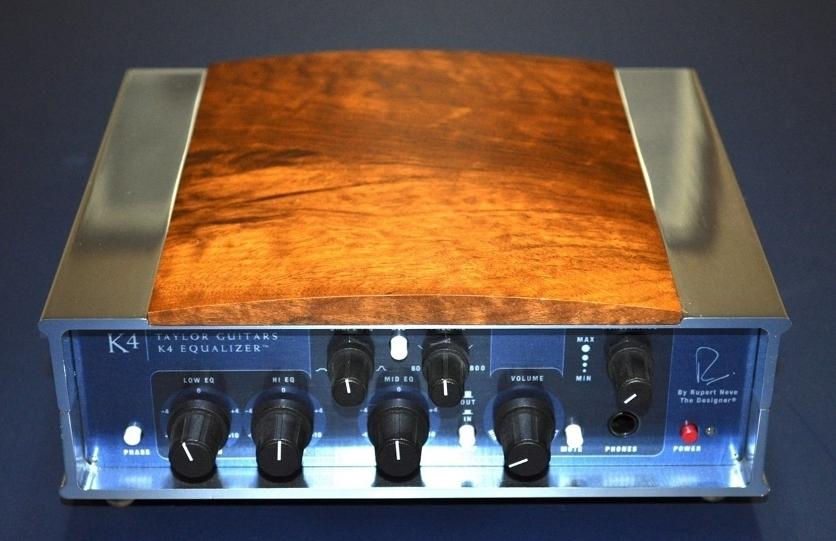
Click images for larger size.
THE BASIC FACTS
What is the Taylor K4? At the core, it is a stand-alone preamp, EQ, and direct box, offering an effects loop, a tuner out, and a headphone amp. Essentially, it is a rudimentary recording console channel strip coupled with a direct box. Physically, this attractive package is a little larger than a typical half-rack effect module but it is a finished stand-alone unit, not a rackable building block. First impressions? Solid. Substantial. This isn’t a lightweight, empty box of air. The works are housed in a hefty, shiny, two-piece extruded aluminum case with recessed front and back panels finished in what I call “Neve console blue.” The case is trimmed out with an attractive, thick sapele wood panel on top and clear rubber feet and threaded sockets to accept an optional mic stand adapter on the bottom. All the connectors except the headphone jack live on the back panel while most of the controls except the set-and-forget switches live on the front panel.
WHAT'S IN THE BOX?
K4 Preamp/EQ module
One Spot external 9v power supply
Comprehensive, thirty-four page written manual
DVD introduction and guide
FEATURES
Balanced and unbalance guitar and mic inputs
Balanced or unbalanced mic and line outputs
Balanced or unbalanced loop with in/out switch and pre/post EQ switch
Master level control
Mute button
Ground lift switch
Phase reverse switch to aid in feedback control
Three band EQ optimized for guitar with bass and treble shelving bands and wide-range, dual band parametric band
Headphone amp with independent volume control and full-sized ¼” jack
1/4” tuner output jack (unaffected by mute)
Emergency battery power via two C cells
WHAT’S IT ALL ABOUT?
With the K4, Taylor appears to have targeted guitar players who want an extremely clean, quiet, smooth preamp and a highly euphonic equalizer for their mono guitar signal, and are willing to pay a little more for a better sound. Now to be sure, there are plenty of EQs and preamps in the world, and many of them are ugly. I remember in the ‘80s working with some brands of professional recording console that had a unique and unfortunate signature: wherever they went, racks of outboard EQs and preamps followed because their own EQs and preamps were so ugly. One in particular might as well have had its bass EQ labeled “boxiness” or “muzziness,” its midrange bands labeled “crashiness” and “spikiness,” and its high EQ labeled “fizziness,” because they were incapable of generating anything musical. Another boasted of wide range boost and cut capabilities, but an unfortunate side effect was that anything but the most gentle boost would drive it into distortion because it had little headroom.
By contrast, Neve inputs and EQs were very musical and full-sounding and also so well-designed that you didn't have to fret about running out of headroom and distorting or creating spiky, ugly sounds as you used the EQ. Frankly, the biggest features of the K4 are the philosophy of its designer, Rupert Neve, and the Neve sound, both in the preamp and in the EQ. Neve is perhaps the single most respected recording console designer in history. His console preamps and EQs are the most sought after in the industry. Single-channel Neve input modules from the '70s still fetch premium prices and are coveted throughout the industry. A few years ago when my company sold one of our Neve recording consoles, several modules were parted out to engineers all over the world before the console was even powered down and taken out of the building. Why is this? It is because Neve's electronics sound lovely. Period.
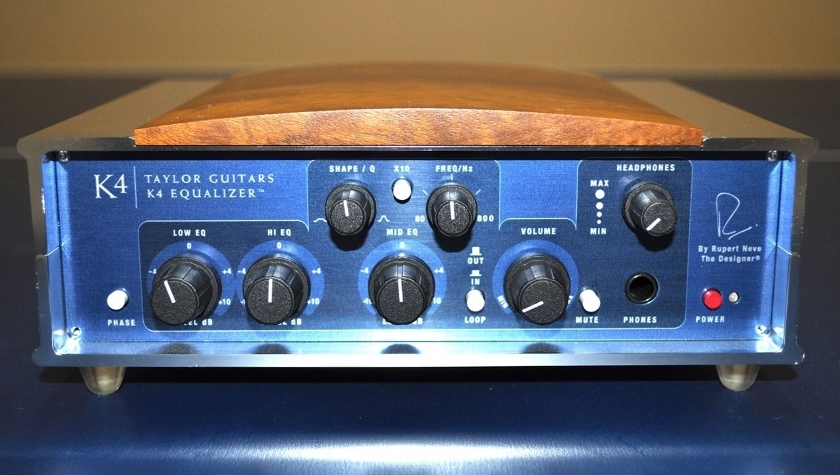
So, because of his abilities and reputation as a designer, Rupert Neve was brought in by Taylor to create this unit. Neve and the Taylor electronics staff identified the most useful EQ centers for guitar and Neve designed the electronics to match the sound of stringed instruments. As a result, if used properly, the preamp exhibits a clean, quiet, full sound and the EQ is extremely musical and euphonic. Okay, you will pay a premium for this box, but those with ears and skill will appreciate its sound. The K4 offers very useful and sweet-sounding bass and treble shelving EQ bands and a single band of fully parametric EQ offering sweepable response from 80-800hz or 800-8khz via a 10x multiplier switch. Using this center band we can get rid of odd resonances in a particular instrument or notch out frequencies that are prone to feedback. Okay, another band of parametric EQ would have been helpful, but I've found the unit to be very useful as-is.
The folks at Taylor wrote up a comprehensive manual that gives you a tour of the ins and outs and the controls of the unit and teaches you exactly how to interface the unit with your particular guitar and application. It's a lot of reading, but sit down with a good cup of coffee and invest the time it takes to read through the manual a couple of times. Because of its complexity this unit does want a little study but it does, by exchange, reward it richly. I repeatedly see people on forums asking the same basic input and output questions about the K4 that they could easily understand if they read the manual. Incidentally, the introductory DVD includes a tutorial on basic EQ types and applications and illustrates and simplifies some of the topics discussed in the manual for those who are hopelessly manual-allergic. They've really gone to great lengths to visually demonstrate the EQ package so you get an idea of the workings of shelving and parametric EQ. There must be some reason Taylor invested the time and effort to create a thirty-four page written manual AND a DVD guide. The reason is that this box is an extremely flexible and useful tool for the guitarist, helping him handle all sorts of situations. With flexibility invariably follows some complexity.
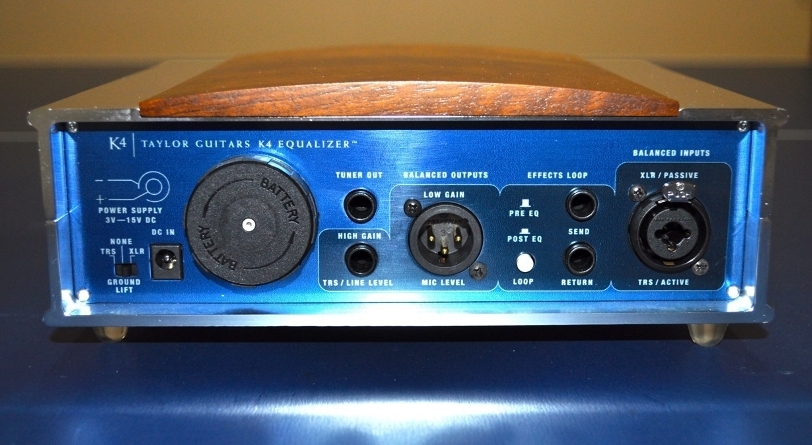
INS AND OUTS
Inputs – Via a nice Neutrik dual jack, the K4 offers both a mic-level XLR input and combined guitar-level TRS balanced or TS unbalanced input.
Outputs – The K4 offers a separate mic-level balanced XLR output and a 1/4” line level TRS balanced or TS unbalanced output. Both are transformer balanced with a very high-quality transformer and can be used simultaneously. If you choose to use the 1/4” line output as an unbalanced out, it will unbalance the XLR out as well because both are fed post the balancing transformer.
Effects loop - The loop can be used with either balanced or unbalanced effects. It is switchable to sit either pre- or post-EQ. Use of unbalanced effects will not unbalance the main output because the insert lives before the balancing transformer.
Power Supply - Though it is designed to run on a three-to-fifteen volt, tip-positive, DC power supply and is shipped with a nine volt “One Spot” power supply, the K4 can be powered with two “C” cell batteries for up to ten hours. When the K4 is powered by batteries, the front panel power LED functions as a battery-strength meter, giving you a warning approximately thirty minutes before the batteries fold up and go home.
Now, there was an initial price point faux pas with this unit. It was originally offered at $800, which violated my “guitarist/delivery principle”: to afford it, a guitarist would have to sell his crappy, 20 year-old, beat up Honda Civic, which would have prevented him from delivering pizza and would thus separate him and his household from his income. At that price point the K4 hardly flew off the shelves. After a short period with everyone scratching their heads, Taylor moved the price down substantially. The units were then available new for $495 virtually everywhere. You can find a nice one used on eBay for about 60% of the retail price.
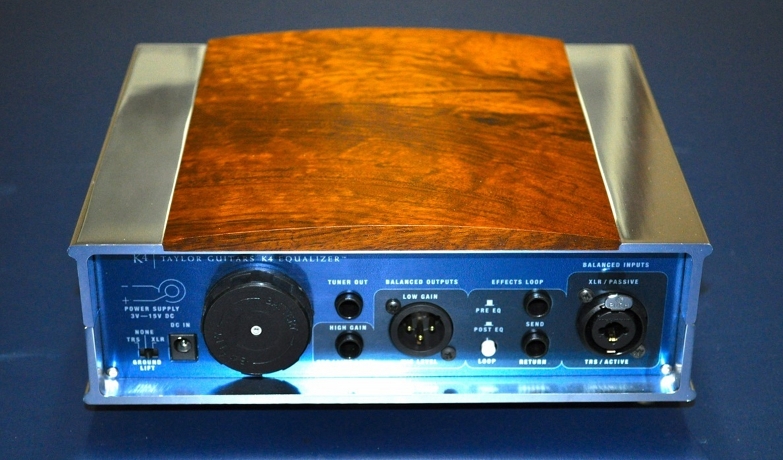
IN SUMMARY
So, is the K4 “All that and a box of chocolates?” Yes, indeed it is, at least in my opinion as a recording engineer and a guitarist. Every once in a while you come across a piece of kit that sets out to accomplish something and ends up doing it admirably. The K4 is one of those items. The basic sound of the unit has the classic Neve input channel sound. The EQ exhibits the typical graceful and silky Neve signal handling with plenty of headroom but without the harsh edges some other input modules can sometimes exhibit. Does it work with guitars other than ones equipped with Taylor’s Expression System? Yes, it works great with any mono guitar signal, including the signal from a dynamic mic. Will it please everyone? No. For instance, it doesn’t blend dual-source inputs. It isn’t the most straightforward, easy, plug-and-play item on the block either. It doesn’t make coffee. Frankly, a hack can still make a muck of a signal with it. Some people may want more comprehensive EQ. If you don't use the inputs and outputs as prescribed you won't get their best benefit, so read the manual. If you are one who prefers to just plug and play, you might be disappointed. I’ve seen it many times when people haven’t invested the time to learn the machine. But it does what it does extremely well, with elegance and grace, and for that it is to be commended.
MY LITTLE K4 CABLE GUIDE:
Because of the many interface options available with this unit, cable choice is paramount to accomplishing your goals. I’ve summarized the input/output possibilities below and listed the cable needed to accomplish the desired connection.
Input side:
Taylor Expression System 1 version A, B, or C equipped guitar: TRS to TRS balanced cable
Typical unbalanced mono acoustic guitar: TS to TS guitar cable
Dynamic microphone: Male to female XLR balanced cable
Condenser microphone: Two male to female XLR balanced cables and a Phantom Power supply box
Typical output cabling:
Balanced mic level: Male to female XLR balanced cable
Balanced line level: Either TRS male to TRS male balanced cable or TRS male (K4 end) to XLR male (mixer end) balanced cable, depending upon the needs of your console
Unbalanced line level: TS to TS shielded guitar cable
UPDATE:
Oh, and by the way, the K4 I used for the review was purchased used from nice fellow on eBay. It arrived missing a couple of screws from the front panel. Knowing that they had the parts somewhere, I called Taylor asking for replacement screws. They cheerfully sent them out via express mail and didn't charge me a cent. I don't know why I was surprised. Bravo to Taylor for continued excellent customer service!
UPDATE TWO (08/18/2017):
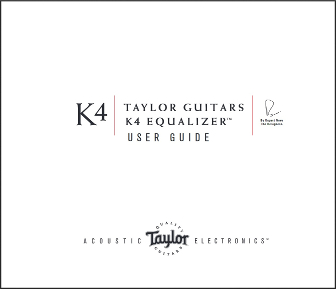
A friend has sent me a copy of the Taylor K4 User's Guide in .PDF form and I'd like to pass it on to you. You can grab a copy by clicking the pic above and then using the menu option "File/Save Page As" to save a copy to your hard drive.
= =
=





